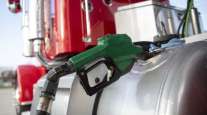Senior Reporter
CARB Staff White Paper: Significant Reductions in NOx ‘Technically Achievable and Cost-Effective’ for MY 2024 Heavy Trucks

Research from the staff of the California Air Resources Board concludes that the regulatory agency’s call for significant reductions in nitrogen oxides emissions are “technically achievable and cost-effective” for model year 2024 heavy trucks.
CARB said its white paper, a technical feasibility assessment, is intended to provide clarity in addressing engine manufacturers’ “concerns and uncertainties” with regard to lead time for regulatory requirements that impact model years 2022-26.
“They all came back to us saying they were trying to set their design plans for 2024 to meet Phase 2 greenhouse gas requirements adopted in California and federally,” said Stephan Lemieux, manager of CARB’s On-Road Heavy-Duty Diesel Section. “They said it would be nice to know and helpful to understand where we’re going to land in 2024 as they also address NOx reductions.”
CARB White Paper by on Scribd
The Phase 2 greenhouse gas final rule, issued June 2016, calls for lowering truck emissions of carbon dioxide and other greenhouse gases in 2021, 2024 and 2027, but left in place the earlier limit on emissions of nitrogen oxide (NOx) at 0.2 gram standard.
There were concerns among some manufacturers that CARB might require significant cuts to NOx emissions as soon as 2022. However, Lemieux said the 2022 requirements are “sort of cleanup issues. They’re not significant.”
But for model years 2024-26, the staff is considering lowering the NOx standard to between 0.05 grams per brake horsepower hour and 0.08 grams per brake horsepower hour, about a 75% reduction. Reaching even that level, when paired with Phase 2 greenhouse gas requirements, is regarded by manufacturers as a “competing challenge,” Lemieux said.
In addition, CARB will in 2022 be adding a process requiring manufacturers to submit warranty claim information and data, looking ahead to more significant warranty extension requirements in later years.
Aside from lowering the NOx standard as soon as 2024, CARB staff is in the process of developing and testing a number of proposed changes, including heavy duty in-use onboard testing, lengthening useful life and warranty periods, clarifying warranty corrective action provisions, and revising durability demonstration procedures, according to the white paper, published April 19. The staff is expected to present its proposal to CARB members in the first quarter of 2020.
For particulate matter, CARB staff believes most engines have certification levels well below the current 0.01 gram per brake horsepower-hour level.
“However, in the last few model years some manufacturers have elected to certify some of their engine families to higher PM emissions levels as a result of changes to the diesel particulate filter substrate,” the paper said.
The CARB staff said that since newly purchased trucks outside of California accrue about 60% of total heavy-duty vehicle miles traveled in the state’s southern region a day, it’s critical that the U.S. Environmental Protection Agency take action to establish a national low-NOx standard for heavy-duty trucks.
“Exacerbating the challenge of cutting overall emissions, the number of vehicles and associated vehicle miles traveled have been continuously increasing each year,” the white paper said.

In response to pressure from more than 20 organizations, including state and local air agencies across the country, EPA announced its “Cleaner Trucks Initiative” in November to reduce NOx emissions from on-road heavy-duty trucks and engines.
The white paper said if the two agencies cannot “harmonize” their NOx regulations, CARB may need to establish a California-only bank for emission credits.
In a Truck Industry Meeting presentation earlier this month, EPA said it was currently in the information gathering stage and is planning to publish a proposed rule sometime in 2020. After that, it will accept and analyze comments and at some time afterward issue a final rule.
But Lemieux said EPA isn’t expected to have a final NOx reduction rule in effect until 2027.
For the last three decades, NOx and PM emission standards for heavy-duty on-road engines have become more stringent. For NOx, the standard has decreased from 6.0 grams per brake horsepower hour in 1990 to the current 0.20 grams per brake horsepower hour standard in 2010. For PM, the standard has decreased from 0.6 g/bhp-hr in 1990 to 0.01 g/bhp-hr in 2010.
Likewise, California has also adopted programs that provide substantial in-use emissions reductions such as vehicle idling restrictions and in-use fleet rules, including the Drayage Truck Regulation and the Truck and Bus Regulation.



